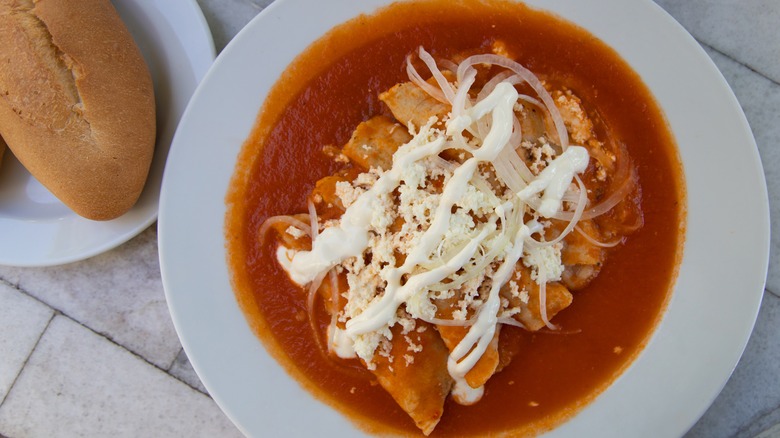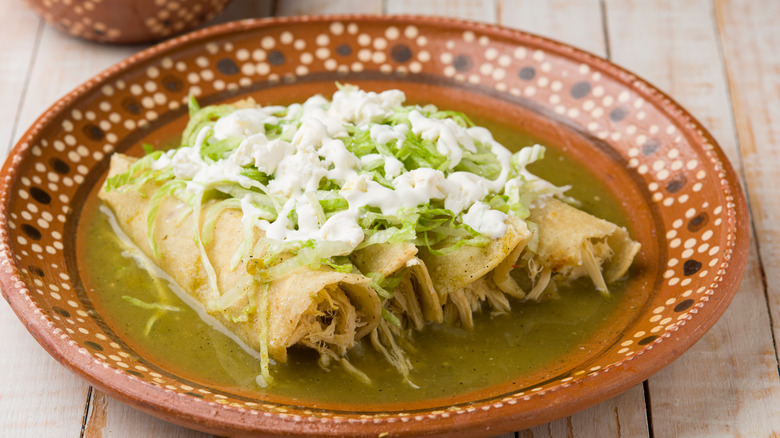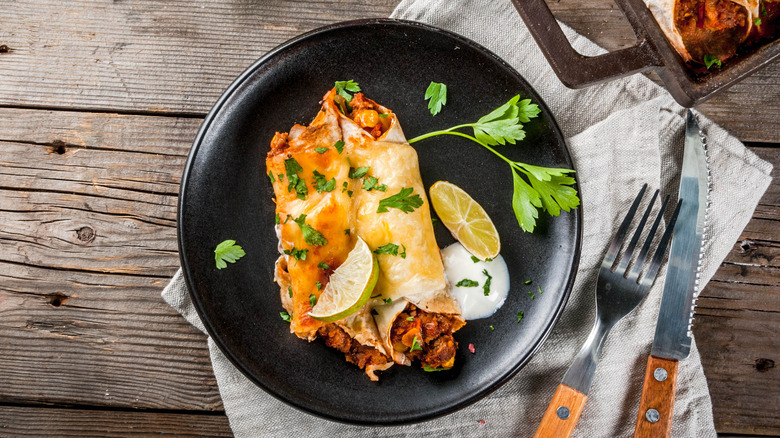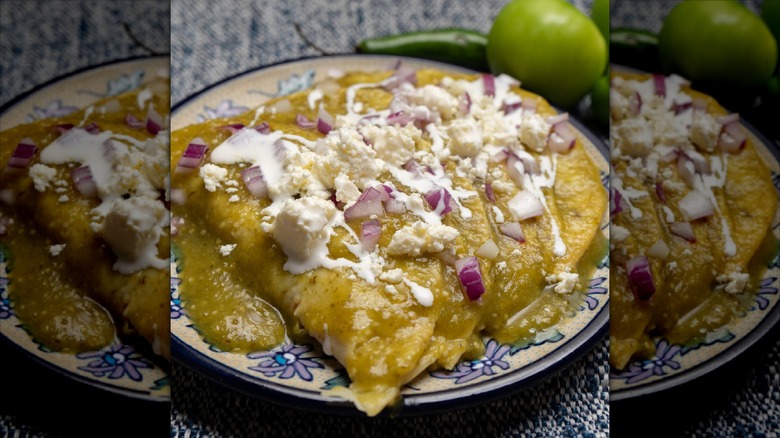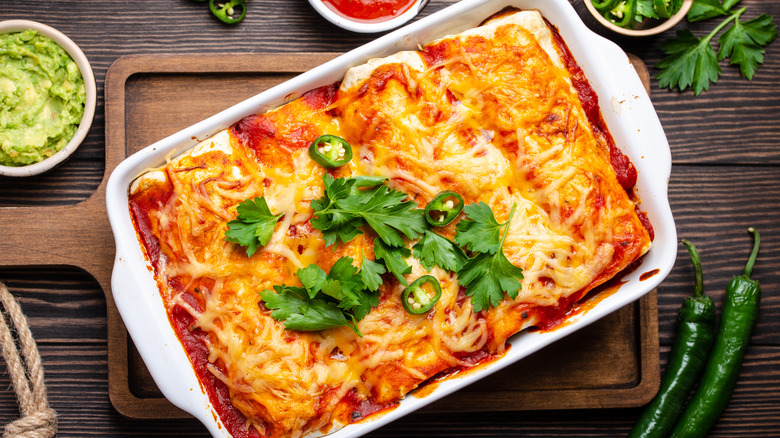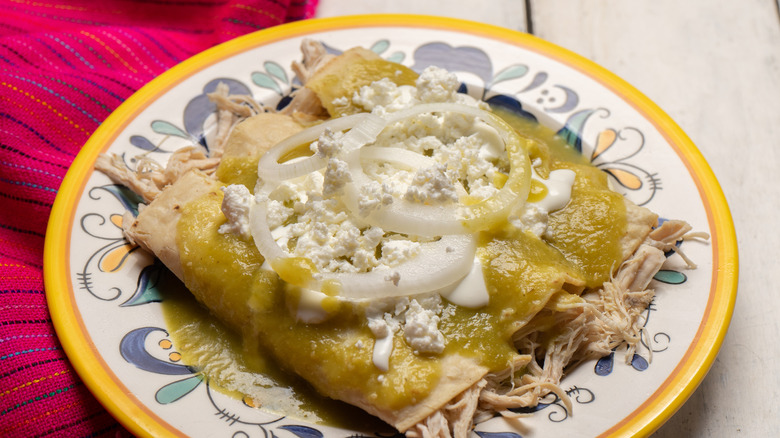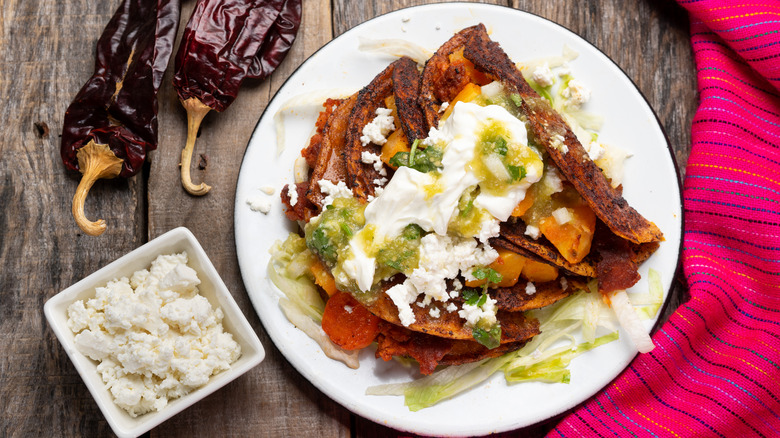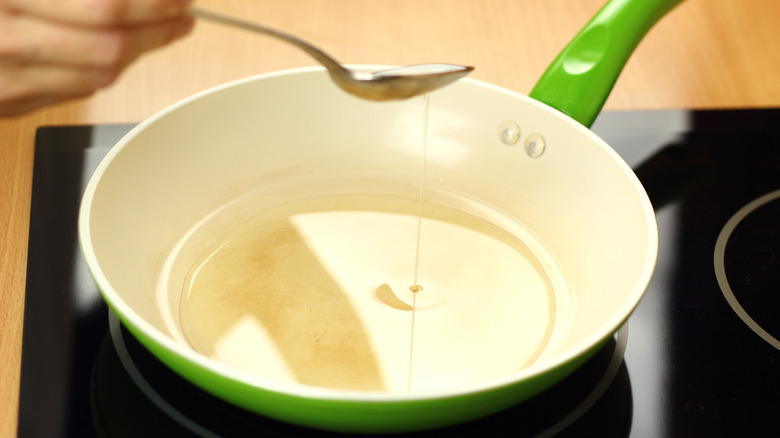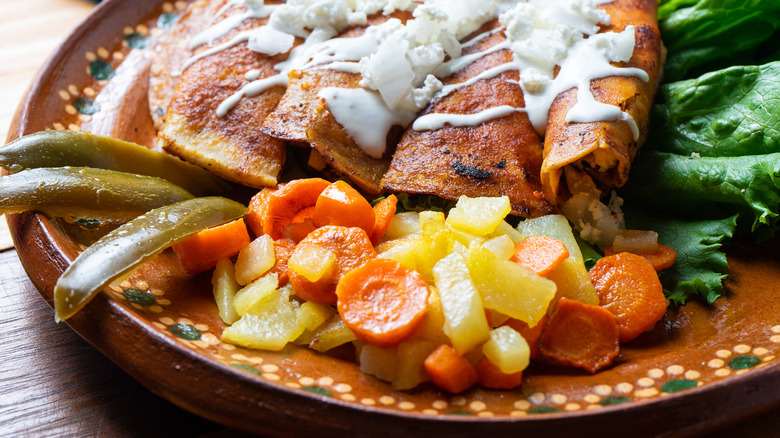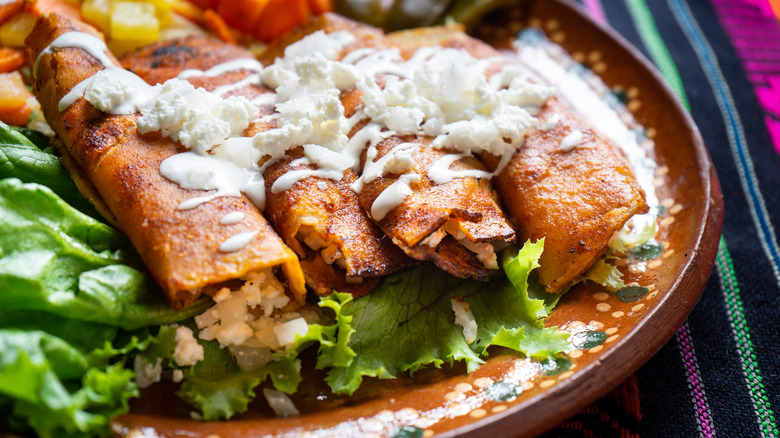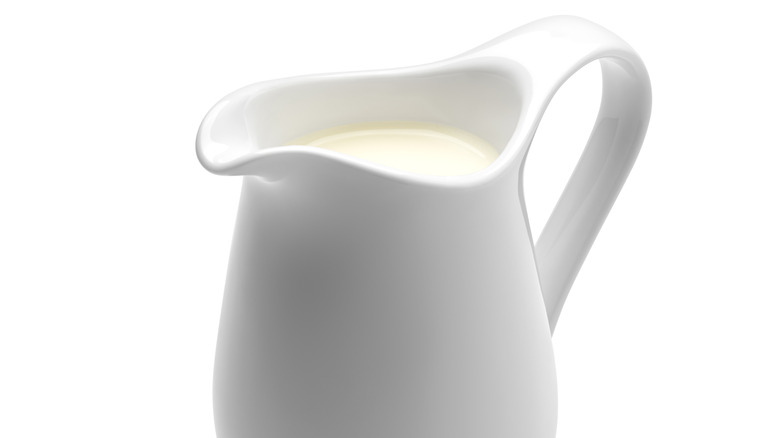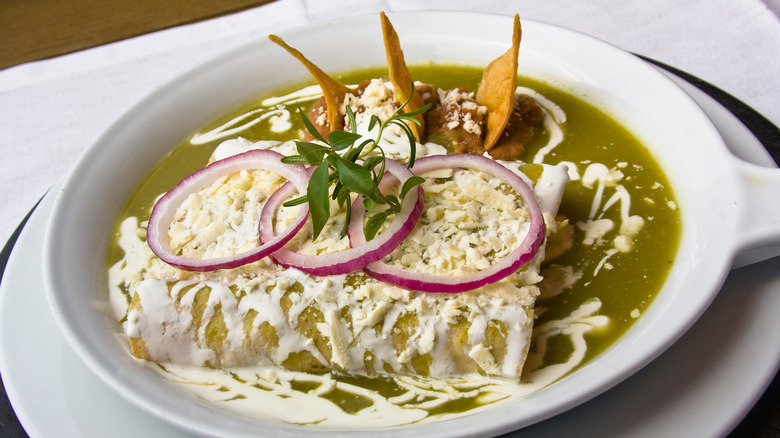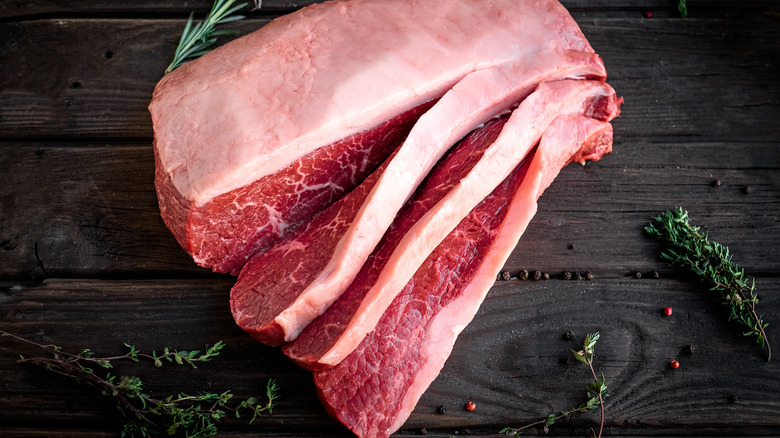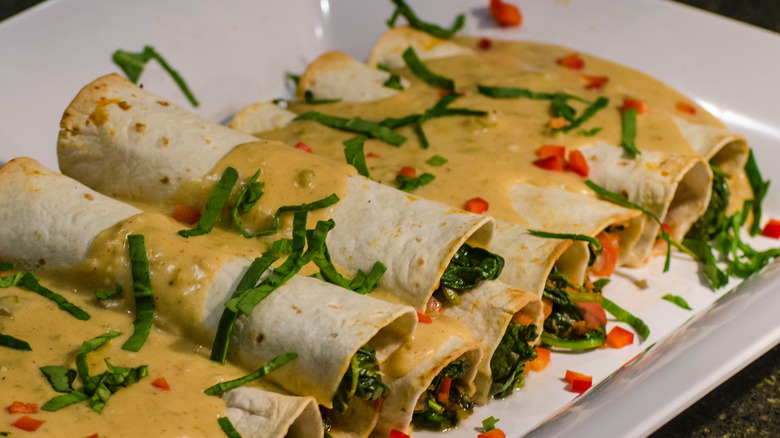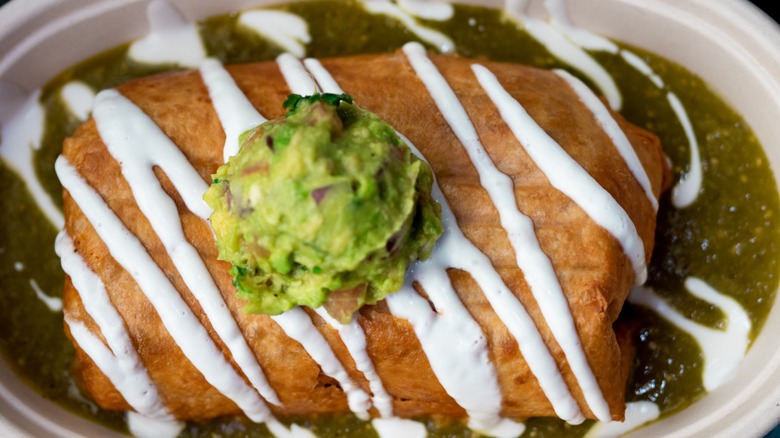14 Enchilada Styles You Can Order For Your Next Meal
Enchiladas are a staple of Mexican cuisine, and you will find them on the menu at almost any Mexican restaurant. This classic dish consists of corn tortillas (though restaurants often use flour tortillas) that are rolled and filled with almost anything, from cheese and beans to shredded chicken or thick chunks of steak, then smothered in sauce and topped with cheese. The word "enchilada" comes from the Spanish word "enchilar," which essentially means "to spice with chilis," so enchilada sauce traditionally contains one or more types of chili peppers.
Most recipes call for baking enchiladas in the oven, but some versions call for frying them on the stovetop. Unlike tacos or burritos, enchiladas are not a finger food. Home cooks often serve them like a casserole while restaurants tend to serve them two or three at a time, but either way, you should eat this cheesy, gooey dish with a with a fork.
Enchiladas are easy to make at home, even for beginners. Tradition calls for prepping the enchilada sauce fresh, but you can easily use canned sauce for a quick version. After the sauce, all you need are tortillas, a filling like pre-cooked rotisserie chicken or canned beans, and shredded cheese. However, nothing is easier than ordering from a restaurant. Here are 14 enchiladas you can order for your next meal.
1. Chicken enchiladas
Chicken enchiladas might just be the most popular type of enchiladas. Even less adventurous eaters usually feel comfortable trying a dish centered around chicken and cheese. Classic chicken enchiladas use shredded or diced pre-cooked chicken as a filling. Most restaurants use flour tortillas for chicken enchiladas, but you can request corn tortillas if you are gluten-intolerant or have celiac disease. Chicken enchiladas are typically smothered with red enchilada sauce, topped with Monterey Jack or cotija cheese, and heated through until the cheese is perfectly melty.
There are many variations on this classic recipe, so take the time to peruse the menu at your local Mexican restaurant to see what else it offers. You might find chicken and chorizo enchiladas that pair chicken with Mexican sausage, white chicken enchiladas that swap red sauce for a sour cream-based white sauce, plus other combinations like chicken and spinach or chicken and beans. Any of these combinations goes well with refried beans and Mexican rice on the side.
2. Beef enchiladas
You will find ground beef enchiladas on the menu at just about any Mexican restaurant. Like chicken enchiladas, these are a good choice for diners who want to try Mexican food but are a little leery of new flavors. Ground beef enchiladas are usually made from flour tortillas stuffed with cooked ground beef and topped with red sauce and cheese. Some restaurants offer ground sirloin instead. You may also see enchiladas filled with flank steak or shredded brisket or chuck.
Red enchilada sauce is made from dried chili peppers that have been cooked in broth and pureed. Mexican chef often have their own recipe for red enchilada sauce, so expect the flavor and the spice level to vary from restaurant to restaurant. You can also try beef enchiladas smothered in molé sauce. The foundation of molé sauce is chocolate. Sounds weird, but it's actually delicious! Molé sauce uses unsweetened chocolate along with chili peppers, chicken stock, and spices to create a rich sauce that pairs well with beef or other enchilada toppings like chicken and pork. Some recipes use peanuts, so be sure to alert your server if you have any food allergies.
3. Cheese enchiladas
Cheese enchiladas are a great option for vegetarians dining out at a Mexican restaurant. This simple dish consists of tortillas stuffed with cheese and baked to melty, gooey goodness. Many restaurants use cheddar, Monterey jack, cotija, or queso blanco for their cheese enchiladas. Cotija is a hard white cheese that gets its name from the town Cotija in Michoacán (per Cheese.com), while queso blanco is a soft white cheese made from cow's milk and sometimes mixed with goat's milk, according to Cheese.com. Both cheeses are popular in Mexican cuisine and make a great filling for enchiladas.
Cheese enchiladas may come smothered in red or green sauce, authentically known as salsa verde. Salsa verde gets its green color from tomatillos, a fruit that looks like a green tomato wrapped in thin paper but has a flavor all its own. This sauce uses tomatillos that have been roasted or cooked on the stovetop along with onions, garlic, cilantro, and lime juice to create a bright flavor. The green sauce contrasts with the white of the tortillas and cheese for an enticing presentation.
4. Enchiladas rojas
"Roja" is the Spanish word for "red," so "enchiladas rojas" simply means "red enchiladas." These enchiladas come slathered in red enchilada sauce that is made from a combination of several chili peppers. Many Mexican restaurants will make their red enchilada sauce from scratch, so expect some variation between establishments.
Dried peppers such as ancho, guajillo, pasilla, and arbol chili peppers serve as the foundation for salsa roja. Chefs take dried, whole peppers and then pan roast them alongside fresh garlic and onions. After roasting the peppers, chefs remove the seeds and membranes (the spiciest part of the peppers), soak them in boiled water or broth, and then puree into a smooth, red sauce. In other words, red enchilada sauce is basically a serving of pure vegetables.
Red sauce pairs well with any filling, so you can order red enchiladas stuffed with chicken, beef, pork, cheese, beans, or veggies. If you can't make up your mind, order a trio of three different fillings!
5. Enchiladas verdes
Enchiladas verdes, or green enchiladas, come with a bright green sauce based on tomatillos (that green tomato lookalike), cilantro, and green chili peppers such as serrano, jalapeño, Anaheim, and Hatch chilis. The sauce starts with boiled tomatillos which are then blended with onion, garlic, cilantro, and chili peppers. Chefs can alter the spice level of their green sauce by changing the proportion of chili peppers; more peppers means more heat.
Shredded chicken is the most popular filling for green enchiladas. The crisp flavor of verde sauce pairs nicely with the mild flavor of chicken. However, feel free to experiment by ordering your favorite filling. Many restaurants offer a trio sampler of three different enchiladas with three different sauces: red, green, and mole. This trio is a great way to try all three basic enchilada sauces without committing to any of them. Another fun presentation that you might find around Cinco de Mayo is an enchilada version of the Mexican flag: one enchilada with verde sauce, one with roja sauce, and one in the middle smothered in white cheese.
6. Enchiladas potosinas
Mexico is a big country with a variety of local cuisines. As Americans, we often think of Mexican food as beans, rice, and beef tacos, but there's a lot more to Mexican cuisine than that. It seems like every region has its own version of enchiladas, and San Luis Potosi is no exception. Enchiladas potosinas hail from this state in north-central Mexico.
Enchiladas potosinas look a little bit different than traditional enchiladas, but they still taste great! While most enchiladas start with tortillas, enchiladas potosinas start with fresh masa harina, the corn flour used to make tortillas, and ancho peppers. When chefs make these enchiladas, they start by making fresh tortilla dough infused with ancho chilis, which gives the enchiladas a bright red-orange color. After kneading the tortilla dough, the chef fills it (usually with cheese) and then folds it in half and fries it. These fried enchiladas can be topped with a variety of sauces, more cheese, avocado, lettuce, diced tomatoes, and sour cream.
7. Enchiladas del suelo
Sinaloa is a Mexican state located in northwestern Mexico, with miles of coastline along the Pacific Ocean and Gulf of California. Enchiladas del suelo are a regional specialty specific to the state. While these enchiladas are not common in the United States, you might find them on the menu if you're lucky enough to stumble across a Mexican restaurant with a chef from Sinaloa. Enchiladas del suelo feature chorizo, a type of Mexican sausage.
Chorizo is made from ground pork seasoned with ancho and guajillo chili peppers, garlic, onions, paprika, coriander, and cumin. It has just the right amount of heat without being too spicy. Enchiladas del suelo are filled with chorizo and served open-faced instead of rolled. The chef dips the tortillas into red enchilada sauce and then fries the tortillas and tops them with chorizo, queso fresco, diced tomatoes and onions, chopped lettuce, and slices of avocado.
8. Enchiladas norteñas
"Enchiladas norteñas" simply means "northern enchiladas." These enchiladas come from northern Mexico and have two key differences from classic enchiladas: They are served folded instead of rolled and with the sauce added before cooking, not after as a topping. When making enchiladas norteñas, the tortillas are dipped in red sauce before filling them, and they are typically filled with queso fresco or shredded chicken. They can also be prepared with tortillas infused with chili peppers for a similar flavor.
In northern Mexico, enchiladas are traditionally served with a side of fried potatoes and carrots. Most Mexican restaurants in America serve enchiladas with refried beans and rice on the side, but you can always ask for potatoes and carrots for a more authentic experience.
To round out your meal, ask your server if the restaurant offers horchata, a traditional Mexican drink made with rice, coconut milk, honey, cinnamon, cloves, and anise. This rich drink is sweet without being overly sweet and perfectly complements the heat of enchiladas.
9. Enchiladas Michoacán
Michoacán is located in western Mexico, with miles of coastline along the Pacific Ocean. It is a popular tourist destination, with visitors pouring in each year to see the monarch butterflies that migrate from North America to spend the winter in a warmer climate. If you visit Michoacán to see the butterflies (or the beaches), make a point to order enchiladas Michoacán while you are there.
This local version of enchiladas starts with corn tortillas dipped in red enchilada sauce and is then pan fried and filled with potatoes that have been boiled, mashed, and rolled into a sausage shape. While potatoes are the traditional filling, other possible fillings include shredded chicken or beans. After being filled, the enchiladas are fried again and topped with lettuce, diced tomatoes, onions, and queso fresco.
Mexico produces more avocados than any other country worldwide, and Michoacán produces the most avocados of any Mexican state (per the History Channel). So what better way to serve enchiladas Michoacán than with slices of avocado on top?
10. Enchiladas de nata
Enchiladas de nata, otherwise known as cream enchiladas, come from the Gulf coast of Mexico and are popular in cities such as Tuxpan, Poza Rica, Xico, and Veracruz. Enchiladas de nata are topped with a cream sauce, hence the name. The most common filling for enchiladas de nata is shredded chicken, but you can also find them filled with shredded beef or pork. Some restaurants may offer vegetarian enchiladas de nata with options like refried beans, cheese, or even scrambled eggs. This dish doesn't really lend itself to vegan alternatives, so if you follow a vegan diet, stick with bean- or vegetable-filled red or green enchiladas.
The cream sauce for enchiladas de nata is not a white cream sauce but instead is a reddish-pink, a color that comes from diced tomatoes. The base of this cream sauce is a mixture of sautéed tomatoes, chili peppers (often guajillo or ancho chili peppers), and onions. Once sautéed, the veggies are soaked in boiling broth and then removed from the heat before adding cream. The result is a rich sauce that takes enchiladas to the next level.
11. Enchiladas suizas
Enchiladas suizas, or Swiss enchiladas, may get their name from Switzerland, but this dish pops up on the menu at a lot of Mexican restaurants in the United States. Enchiladas suizas were influenced by Swiss immigrants to Mexico, who brought with them a love of dairy products and the knowledge and skills to produce them (per the San Francisco Chronicle). Their cultural influence shows up in dairy-rich foods like Swiss enchiladas, which incorporate the Mexican version of crème fraîche known as crema Mexicana and a lot of cheese.
Enchiladas suizas are a type of green enchilada. They consist of a rolled tortilla that is filled with shredded chicken. Many times, chefs add salsa verde to the shredded chicken for flavor. These enchiladas are then topped with a generous serving of crema Mexicana as well as cheeses such as manchego, Monterey Jack, Oaxaca, or mozzarella. Culinary legend has it that the white cheese topping on these enchiladas makes them resemble the Swiss Alps — you be the judge!
Try enchiladas suizas with a side of Mexican rice and refried or black beans and, of course, a margarita!
12. Enchiladas regias
If you are feeling regal, try ordering enchiladas regias, aka regal enchiladas. These enchiladas are fit for a king, so treat yourself! You deserve it.
Enchiladas regias are a type of enchilada roja. Some chefs take their roja sauce to the next level for these enchiladas by using ancho chiles, spices such as cinnamon, coriander, and nutmeg, as well as the liquid leftover from cooking pork. This liquid adds a lot of flavor but also means these enchiladas, even when filled with cheese, might not be suitable for vegetarians.
There are several varieties of enchiladas regias, maybe to suit the monarch's mood? You can find these enchiladas filled with panela cheese (a Mexican version of cottage cheese, per Cheese.com), chorizo, shredded pork, and machaca, a type of authentic Mexican shredded beef. Machaca is prepared by marinating beef brisket in a mixture of coffee, cider vinegar, lime juice, red wine, and tomato juice that has been seasoned with pasilla chili peppers, chili powder, cinnamon, garlic, and cocoa powder and then slow cooking the brisket to produce a soft, delectable, shredded beef that is perfect for enchiladas as well as tacos or burritos.
13. Vegetarian enchiladas
While Mexican food (at least the American restaurant version) tends to be heavy on the meat and cheese, more and more restaurants are expanding their vegetarian options. Cheese enchiladas have always been a menu staple, so feel free to order these tried-and-true vegetarian enchiladas the next time you are out. But take a minute to explore the menu because many restaurants offer two or three options for vegetarian enchiladas.
Spinach enchiladas are a popular vegetarian option for enchiladas. These enchiladas are usually filled with sautéed spinach and then topped with red or green enchilada sauce and cheese. Some restaurants also offer vegetable-filled enchiladas that use the same vegetables used for vegetarian fajitas. Fajita veggies typically include summer squash, zucchini, onions, mushrooms, and carrots. Potato enchiladas, which may be filled with mashed potatoes or cubed, fried potatoes, or bean enchiladas are some additional options.
If you don't see vegetarian enchiladas on the menu, just ask your server if the chef can make them for you. Most chefs will be happy to throw something together for you. If you would like vegan enchiladas, simply ask the chef to make you enchiladas filled with beans or vegetables and omit the cheese on top.
14. Chimichangas
Now, purists might argue that chimichangas aren't really enchiladas, and they're not wrong. But that doesn't mean you shouldn't order them the next time you're out for Mexican food. This dish puts a twist on traditional Mexican cuisine, and the result is fantastic.
A chimichanga is basically a deep-fried burrito, but it is served like an enchilada and eaten with a fork and knife. Chimichangas tend to be smaller than burritos and consist of a flour tortilla that has been filled, rolled, deep-fried, and then smothered in toppings. Chimichangas are typically filled with meat, such as shredded chicken, pork, or beef, but if you are a vegetarian, ask the chef to fill yours with beans or cheese. Popular toppings include enchilada sauce, cheese, sour cream, chopped lettuce, diced tomatoes, and jalapeños.
Since the chimichanga is not an authentic Mexican dish, it varies widely between restaurants based on the preferences and style of that restaurant's chef. It's hard to mess up the deep-fried goodness of a chimichanga, so go on and try one the next time you're out.
